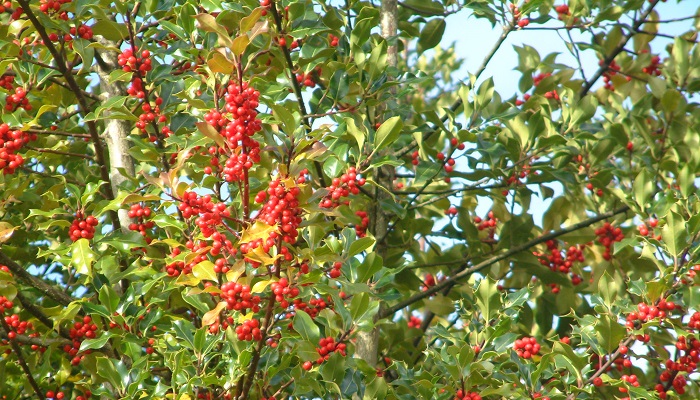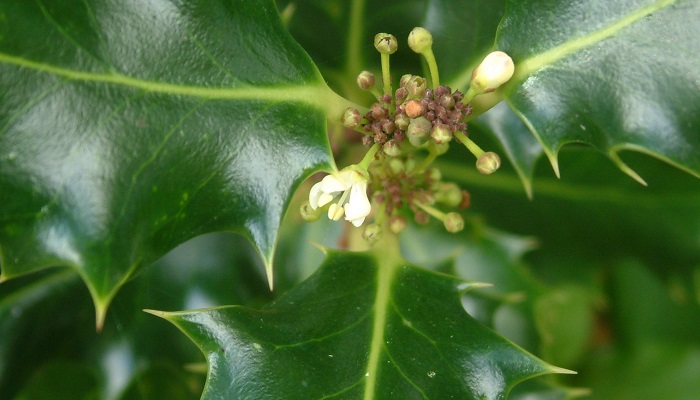22 December 2024
A noble of the wood – plant a holly for the future

Is holly brightening your home this Christmas? Have you considered planting this noble of the wood? In this article, Catherine Keena, Teagasc Countryside Management Specialist, explores the many benefits holly trees bring to our landscapes and biodiversity.
Perhaps you bought bunches of holly — hopefully cut in a sustainable manner, without overexploitation, which has destroyed some holly stands. Or maybe you harvested some from your own farm, leaving some berries for the birds.
Holly grows in dry, well-drained soils, sands, and gravel, under both acidic and alkaline conditions. It prefers neutral to acidic peaty soils and will not grow on wet sites.
Holly is tough and adaptable, tolerant of exposed sites and shade. It grows in places as varied as woodlands, heathlands, and mountainsides. It is found in ancient Atlantic oak woodlands, and in the Burren, holly grows in the fissures or grykes of the limestone paving, although its height is restricted by wind and grazing livestock.
Holly is a visually attractive small tree, very suited to gardens as an individual tree or as a hedge that retains its green leaves through the winter, making it ideal for screening and privacy. It copes well with pollution and blocks noise. It is a good option around houses in the countryside, instead of planting non-native hedging. Because of its tolerance of clipping, holly is an excellent hedging plant. While it coppices well, there is seldom any need to coppice as holly tends to fill out at the base.
Holly is very hardy, resilient, and long-lived. While slow-growing, it can reach 20m. It forms a tough evergreen, stockproof barrier, impenetrable by cattle, resembling a green wall when mature.
It is an excellent option for growing in shady areas or beneath large trees, as it is an understory species of native woodlands and is often found in older hedges. Due to its shade tolerance, it is a good choice for filling gaps in hedges.
Establishing holly
In the natural world, the flesh of the holly berry is a juicy bundle of nutrients, with the seed hidden inside. This berry is ejected a distance away from the parent plant, along with organic fertiliser. Seeds are encased in a tasty fruit to entice an animal to eat it.
Holly is the only native tree species in which male and female flowers are carried on separate plants, so reproduction depends on insects ferrying pollen from plant to plant. Both male and female plants are required to produce berries, and both bear small, creamy white, four-petalled flowers. Female trees can be identified by the green orbs in the flower centre, which swell to become berries. These are surrounded by four protrusions, the remnants of stamens, which never develop.
Pollen is ferried from powder-tipped, club-like anthers on the males by flies, hoverflies, and a range of bees, including honeybees, bumblebees, mining bees, and leaf-cutting bees. Bright red holly berries are found only on female trees.
A holly bred from generations of holly grown outside Ireland may flower and set seed at a different time to those that have evolved in Ireland. Irish bees, butterflies, and other invertebrates have evolved to time the key stages of their life cycle with the first flush of leaves or flowers. It is better to sow holly plants from berries collected from holly trees that have grown in Ireland for the past ten thousand years. Buy holly plants of Irish provenance, or collect holly berries to grow yourself.

A flowering holly
Wearing tough gloves, pick fully ripe berries anytime over the winter. It can be difficult to remove the flesh from the berries, but this can be facilitated by stratification, a process where the berries are placed in damp sand in a cool place for the following year, to be sown in spring 2025. Even with stratification, germination can be erratic. After a full year of stratification, sow thinly and cover to protect from mice and birds. The following year, transplant to grow for a further two years before planting in their final location. Holly is difficult to establish, and plants must be lifted when the roots are actively growing, so it is recommended to transplant into pots or plugs for these two years. Holly is usually sold in plugs rather than bare-rooted plants.
Holly can also grow from cuttings. In September, select a small side shoot about 15cm long, with the heel where it joins the main branch, and sow it in a sheltered area in a sand/loam mix, protecting it from frost damage. Once well-established but under 20cm tall, move the cutting when the soil is warm. Holly seedlings are susceptible to frost damage.
The cultural significance of holly
The Old Irish Tree List was compiled in the eighth century. Trees were classified according to economic value and status. There are four classes, with seven trees in each class. Holly was in Class 1 — the nobles of the wood. The Class 1 trees were also the most prominent species in terms of individual sacred trees. Venerable holly trees are a common feature at ancient assembly places for the harvest festival of Lughnasadh. Later, mass stones and trees served primarily as landmarks for the community to identify the designated place at which to assemble for mass. Mass bushes were generally holly or whitethorn trees.
Prayerful offerings from pilgrims continue to this day, with rags, ribbons, and other objects attached to old holly trees. Examples include: Altadaven Woods in Clogher, Co. Tyrone; St Senan’s on Scattery Island; St Berrihert’s Kyle or Kilberrihert, in Ardane, Co. Tipperary; and Tobernalt in Co. Sligo. A holly tree in Meenaneary, Co. Donegal, was said to have grown from a spear hurled by St Colmcille.
In folklore, holly was a gentle bush belonging to the fairies, and it was deemed unlucky to cut it down. Cuileann as Gaeilge appears in many place names, such as Moycullen and Glencullen. In the medieval Ogham tree-based alphabet, holly is represented by the letter T.
One of the few traditions lasting since pre-Christian times, still practiced in Ireland today, is the decoration of homes with holly sprigs at Christmas, as our ancestors did — a sign of green life to come. The bright berries were believed to ward off evil spirits.
Holly was planted near houses for protection from lightning, although it burns very well! The spines of the leaves were thought to act as lightning conductors. The sharpness of the leaf spines may relate to the Latin name Ilex aquifolium, which may refer to the Aquila eagle’s sharp talons, with acus meaning needle.
With age and height, the spiky, deterring leaves become smoother. While holly drops its leaves, particularly in summer, it is one of only three evergreen native trees — the others being Scots pine and juniper. These trees do drop their leaves throughout the year, especially in the heat of summer.
Biodiversity
The spiny little snail Acanthinula aculeata is often found among the dead holly leaves. The holly parachute mushroom Marasmius hudsonii is an attractive tiny fungus found at the base of holly on the dead leaves. Other associated biodiversity includes Tar spot Phytophthora ilicis and holly leaf miner Phytomyza ilicis, a fly whose larvae grow from eggs injected into the surface of the leaf on the green tissues sandwiched between the cuticles. This leaf miner, in turn, is the basis of a complex of parasites and hyperparasites, all of which can be food for insect-eating birds.
Holly is the food plant of the caterpillars of the holly blue butterfly Celastrina argiolus, which live in the flower buds of holly. Sometimes there is a second brood, which feeds in late summer on the flower buds of ivy. Holly flowers are also very attractive to bees.
The dense foliage, with hard, leathery, prickly leaves, provides cover for small birds when other trees and hedges are bare, as well as good roosting sites for birds in winter. Berries are eaten by redwings, song thrushes, and mistle thrushes. Young leaves are eaten by animals, especially goats and hares. Dried and bruised holly leaves were used as winter fodder.
Wood
Holly wood is pale, hard, and fine-grained, valued for wood carving, engraving, and turning. It is very dense, between 750 and 800kg/m³ at 12% moisture content, and burns well. It can be readily stained and has been used as a substitute for ebony when stained black, in the making of chess pieces. It saws and planes well, and its hardness and even grain made it very suitable for the shafts of carts and chariots. It is strong enough to be used in hand tools. It was also used for cooking spits, and birdlime was prepared from the bark.
